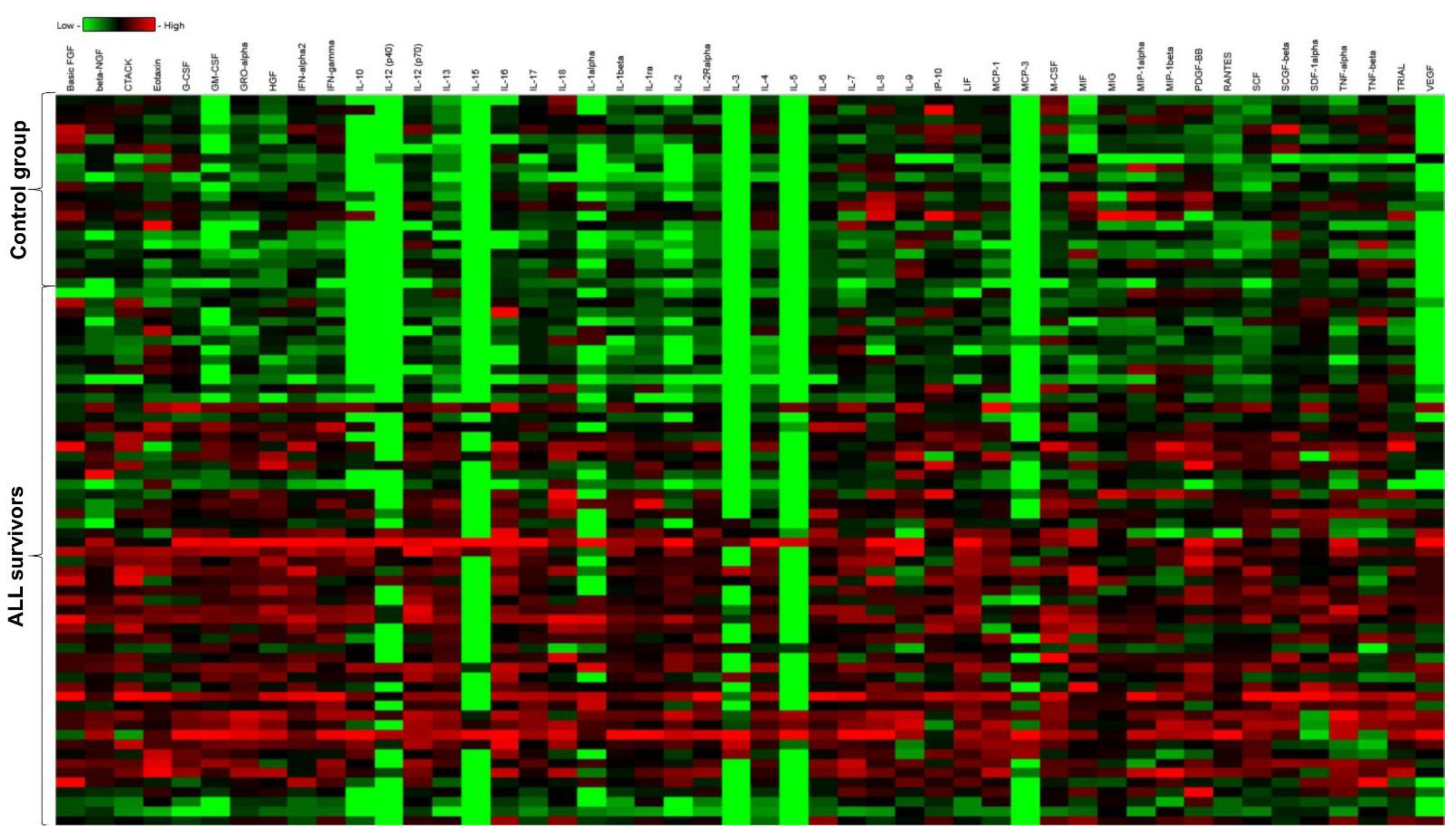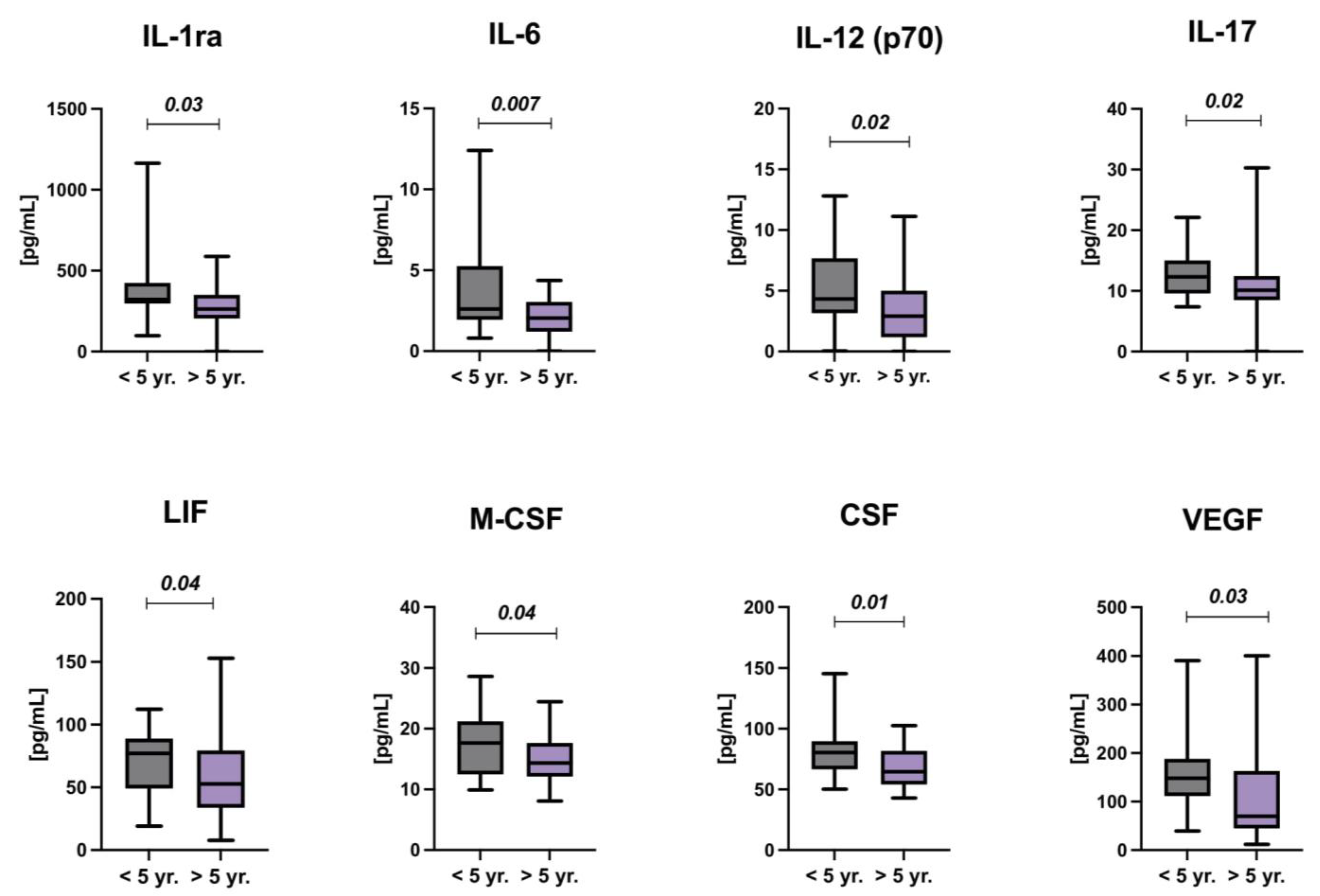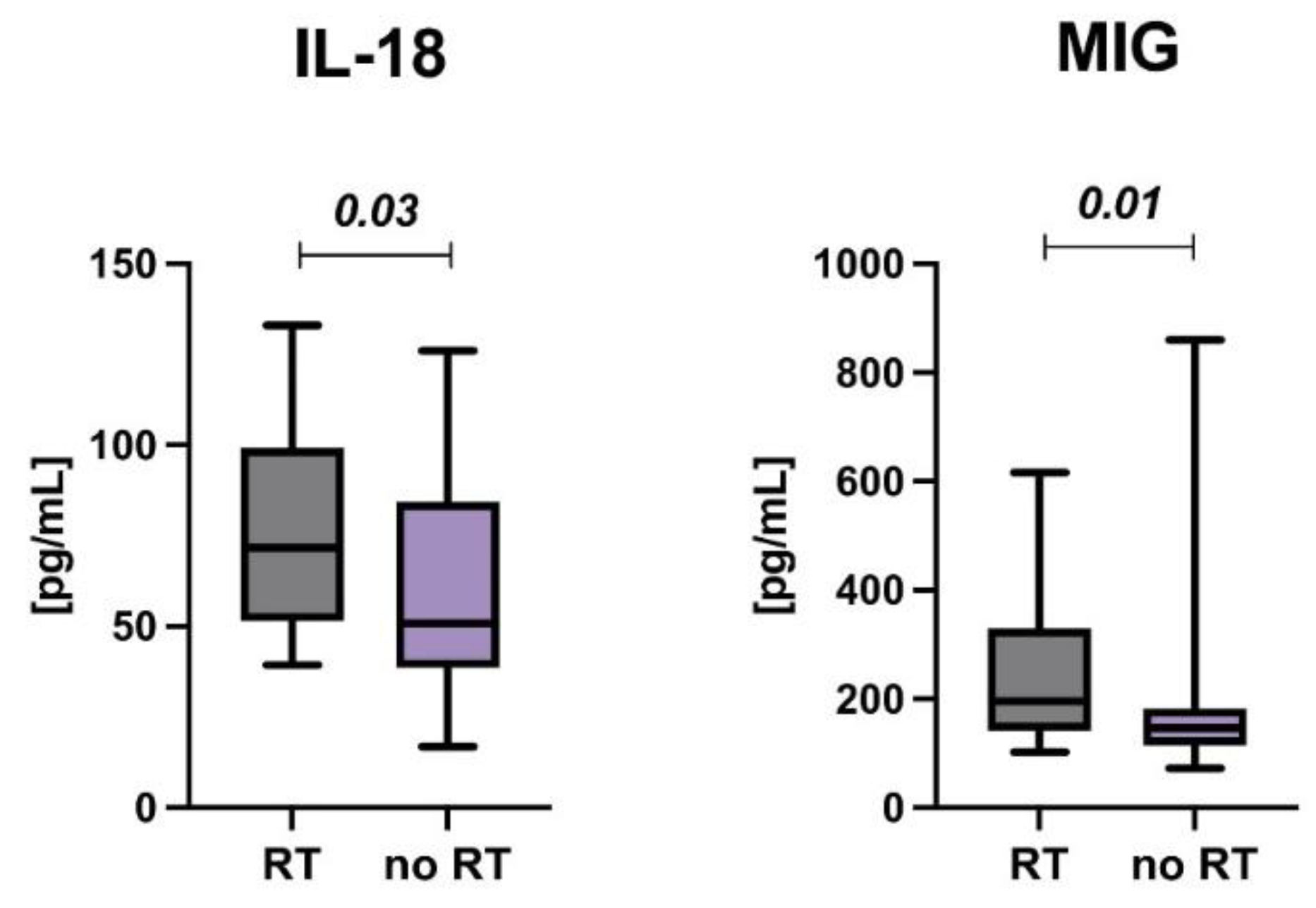Asymptomatic Survivors of Childhood Acute Lymphoblastic Leukemia Demonstrate a Biological Profile of Inflamm-Aging Early in Life
Abstract
:Simple Summary
Abstract
1. Introduction
2. Materials and Methods
2.1. Study Population
2.2. Multiplex Immunoassay
2.3. Statistical Analysis
3. Results
4. Discussion
5. Conclusions
Author Contributions
Funding
Institutional Review Board Statement
Informed Consent Statement
Data Availability Statement
Conflicts of Interest
References
- Einsiedel, H.G.; von Stackelberg, A.; Hartmann, R.; Fengler, R.; Schrappe, M.; Janka-Schaub, G.; Mann, G.; Hählen, K.; Göbel, U.; Klingebiel, T.; et al. Long-Term Outcome in Children With Relapsed ALL by Risk-Stratified Salvage Therapy: Results of Trial Acute Lymphoblastic Leukemia-Relapse Study of the Berlin-Frankfurt-Münster Group 87. J. Clin. Oncol. 2005, 23, 7942–7950. [Google Scholar] [CrossRef]
- Zawitkowska, J.; Lejman, M.; Drabko, K.; Zaucha-Prażmo, A.; Płonowski, M.; Bulsa, J.; Romiszewski, M.; Mizia-Malarz, A.; Kołtan, A.; Derwich, K.; et al. First-Line Treatment Failure in Childhood Acute Lymphoblastic Leukemia: The Polish Pediatric Leukemia and Lymphoma Study Group Experience. Medicine. 2020, 99, e19241. [Google Scholar] [CrossRef]
- Krawczuk-Rybak, M.; Panasiuk, A.; Stachowicz-Stencel, T.; Zubowska, M.; Skalska-Sadowska, J.; Sęga-Pondel, D.; Czajńska-Deptuła, A.; Sławińska, D.; Badowska, W.; Kamieńska, E.; et al. Health Status of Polish Children and Adolescents after Cancer Treatment. Eur. J. Pediatr. 2018, 177, 437–447. [Google Scholar] [CrossRef] [Green Version]
- Salz, T.; Baxi, S.S.; Raghunathan, N.; Onstad, E.E.; Freedman, A.N.; Moskowitz, C.S.; Dalton, S.O.; Goodman, K.A.; Johansen, C.; Matasar, M.J.; et al. Are We Ready to Predict Late Effects? A Systematic Review of Clinically Useful Prediction Models. Eur. J. Cancer 2015, 51, 758–766. [Google Scholar] [CrossRef] [Green Version]
- Oeffinger, K.C.; Mertens, A.C.; Sklar, C.A.; Kawashima, T.; Hudson, M.M.; Meadows, A.T.; Friedman, D.L.; Marina, N.; Hobbie, W.; Kadan-Lottick, N.S.; et al. Chronic Health Conditions in Adult Survivors of Childhood Cancer. N. Engl. J. Med. 2006, 355, 1572–1582. [Google Scholar] [CrossRef]
- Rossi, F.; Di Paola, A.; Pota, E.; Argenziano, M.; Di Pinto, D.; Marrapodi, M.M.; Di Leva, C.; Di Martino, M.; Tortora, C. Biological Aspects of Inflamm-Aging in Childhood Cancer Survivors. Cancers 2021, 13, 4933. [Google Scholar] [CrossRef]
- Wang, S.; Prizment, A.; Thyagarajan, B.; Blaes, A. Cancer Treatment-Induced Accelerated Aging in Cancer Survivors: Biology and Assessment. Cancers 2021, 13, 427. [Google Scholar] [CrossRef]
- Ravera, S.; Vigliarolo, T.; Bruno, S.; Morandi, F.; Marimpietri, D.; Sabatini, F.; Dagnino, M.; Petretto, A.; Bartolucci, M.; Muraca, M.; et al. Identification of Biochemical and Molecular Markers of Early Aging in Childhood Cancer Survivors. Cancers 2021, 13, 5214. [Google Scholar] [CrossRef]
- Ness, K.K.; Kirkland, J.L.; Gramatges, M.M.; Wang, Z.; Kundu, M.; McCastlain, K.; Li-Harms, X.; Zhang, J.; Tchkonia, T.; Pluijm, S.M.F.; et al. Premature Physiologic Aging as a Paradigm for Understanding Increased Risk of Adverse Health Across the Lifespan of Survivors of Childhood Cancer. J. Clin. Oncol. 2018, 36, 2206–2215. [Google Scholar] [CrossRef]
- Cupit-Link, M.C.; Kirkland, J.L.; Ness, K.K.; Armstrong, G.T.; Tchkonia, T.; LeBrasseur, N.K.; Armenian, S.H.; Ruddy, K.J.; Hashmi, S.K. Biology of Premature Ageing in Survivors of Cancer. ESMO Open 2017, 2, e000250. [Google Scholar] [CrossRef] [Green Version]
- Akdis, M.; Aab, A.; Altunbulakli, C.; Azkur, K.; Costa, R.A.; Crameri, R.; Duan, S.; Eiwegger, T.; Eljaszewicz, A.; Ferstl, R.; et al. Interleukins (from IL-1 to IL-38), Interferons, Transforming Growth Factor β, and TNF-α: Receptors, Functions, and Roles in Diseases. J. Allergy Clin. Immunol. 2016, 138, 984–1010. [Google Scholar] [CrossRef] [PubMed] [Green Version]
- Turner, M.D.; Nedjai, B.; Hurst, T.; Pennington, D.J. Cytokines and Chemokines: At the Crossroads of Cell Signalling and Inflammatory Disease. Biochim. Biophys. Acta BBA-Mol. Cell Res. 2014, 1843, 2563–2582. [Google Scholar] [CrossRef] [PubMed] [Green Version]
- Krawczuk-Rybak, M.; Latoch, E. Risk Factors for Premature Aging in Childhood Cancer Survivors. Dev. Period Med. 2019, 23, 97–103. [Google Scholar] [PubMed]
- Koelman, L.; Pivovarova-Ramich, O.; Pfeiffer, A.F.H.; Grune, T.; Aleksandrova, K. Cytokines for Evaluation of Chronic Inflammatory Status in Ageing Research: Reliability and Phenotypic Characterisation. Immun. Ageing 2019, 16, 11. [Google Scholar] [CrossRef] [Green Version]
- Ariffin, H.; Azanan, M.S.; Abd Ghafar, S.S.; Oh, L.; Lau, K.H.; Thirunavakarasu, T.; Sedan, A.; Ibrahim, K.; Chan, A.; Chin, T.F.; et al. Young Adult Survivors of Childhood Acute Lymphoblastic Leukemia Show Evidence of Chronic Inflammation and Cellular Aging: Inflammaging in Childhood CA Survivors. Cancer 2017, 123, 4207–4214. [Google Scholar] [CrossRef] [Green Version]
- Polak-Szczybyło, E.; Tabarkiewicz, J. IL-17A, IL-17E and IL-17F as Potential Biomarkers for the Intensity of Low-Grade Inflammation and the Risk of Cardiovascular Diseases in Obese People. Nutrients 2022, 14, 643. [Google Scholar] [CrossRef]
- Karpisheh, V.; Ahmadi, M.; Abbaszadeh-Goudarzi, K.; Mohammadpour Saray, M.; Barshidi, A.; Mohammadi, H.; Yousefi, M.; Jadidi-Niaragh, F. The Role of Th17 Cells in the Pathogenesis and Treatment of Breast Cancer. Cancer Cell Int. 2022, 22, 108. [Google Scholar] [CrossRef]
- Sulicka-Grodzicka, J.; Surdacki, A.; Seweryn, M.; Mikołajczyk, T.; Rewiuk, K.; Guzik, T.; Grodzicki, T. Low-grade Chronic Inflammation and Immune Alterations in Childhood and Adolescent Cancer Survivors: A Contribution to Accelerated Aging? Cancer Med. 2021, 10, 1772–1782. [Google Scholar] [CrossRef]
- Bahri, R.; Bollinger, A.; Bollinger, T.; Orinska, Z.; Bulfone-Paus, S. Ectonucleotidase CD38 Demarcates Regulatory, Memory-like CD8+ T Cells with IFN-γ-Mediated Suppressor Activities. PLoS ONE 2012, 7, e45234. [Google Scholar] [CrossRef]
- Zhang, J.-M.; An, J. Cytokines, Inflammation, and Pain. Int. Anesthesiol. Clin. 2007, 45, 27–37. [Google Scholar] [CrossRef] [Green Version]
- Coll, R.C.; Robertson, A.A.B.; Chae, J.J.; Higgins, S.C.; Muñoz-Planillo, R.; Inserra, M.C.; Vetter, I.; Dungan, L.S.; Monks, B.G.; Stutz, A.; et al. A Small-Molecule Inhibitor of the NLRP3 Inflammasome for the Treatment of Inflammatory Diseases. Nat. Med. 2015, 21, 248–255. [Google Scholar] [CrossRef] [PubMed] [Green Version]
- Sokolowska, M.; Chen, L.-Y.; Liu, Y.; Martinez-Anton, A.; Qi, H.-Y.; Logun, C.; Alsaaty, S.; Park, Y.H.; Kastner, D.L.; Chae, J.J.; et al. Prostaglandin E2 Inhibits NLRP3 Inflammasome Activation through EP4 Receptor and Intracellular Cyclic AMP in Human Macrophages. J. Immunol. 2015, 194, 5472–5487. [Google Scholar] [CrossRef] [PubMed] [Green Version]
- Jones, L.L.; Chaturvedi, V.; Uyttenhove, C.; Van Snick, J.; Vignali, D.A.A. Distinct Subunit Pairing Criteria within the Heterodimeric IL-12 Cytokine Family. Mol. Immunol. 2012, 51, 234–244. [Google Scholar] [CrossRef] [PubMed] [Green Version]
- Sun, L.; He, C.; Nair, L.; Yeung, J.; Egwuagu, C.E. Interleukin 12 (IL-12) Family Cytokines: Role in Immune Pathogenesis and Treatment of CNS Autoimmune Disease. Cytokine 2015, 75, 249–255. [Google Scholar] [CrossRef] [Green Version]
- Jorgensen, M.M.; de la Puente, P. Leukemia Inhibitory Factor: An Important Cytokine in Pathologies and Cancer. Biomolecules 2022, 12, 217. [Google Scholar] [CrossRef]
- Popova, A.; Kzhyshkowska, J.; Nurgazieva, D.; Goerdt, S.; Gratchev, A. Pro- and Anti-Inflammatory Control of M-CSF-Mediated Macrophage Differentiation. Immunobiology 2011, 216, 164–172. [Google Scholar] [CrossRef]
- Ushach, I.; Zlotnik, A. Biological Role of Granulocyte Macrophage Colony-Stimulating Factor (GM-CSF) and Macrophage Colony-Stimulating Factor (M-CSF) on Cells of the Myeloid Lineage. J. Leukoc. Biol. 2016, 100, 481–489. [Google Scholar] [CrossRef]
- Aguilar-Cazares, D.; Chavez-Dominguez, R.; Carlos-Reyes, A.; Lopez-Camarillo, C.; Hernadez de la Cruz, O.N.; Lopez-Gonzalez, J.S. Contribution of Angiogenesis to Inflammation and Cancer. Front. Oncol. 2019, 9, 1399. [Google Scholar] [CrossRef] [Green Version]
- Tayel, S.I.; El-Hefnway, S.M.; Abd El Gayed, E.M.; Abdelaal, G.A. Association of Stem Cell Factor Gene Expression with Severity and Atopic State in Patients with Bronchial Asthma. Respir. Res. 2017, 18, 21. [Google Scholar] [CrossRef] [Green Version]
- Horio, S.; Fujimoto, K.; Mizuguchi, H.; Fukui, H. Interleukin-4 up-Regulates Histamine H1 Receptors by Activation of H1 Receptor Gene Transcription. Naunyn. Schmiedebergs Arch. Pharmacol. 2010, 381, 305–313. [Google Scholar] [CrossRef]
- Chen, Z.; Flores Castro, D.; Gupta, S.; Phalke, S.; Manni, M.; Rivera-Correa, J.; Jessberger, R.; Zaghouani, H.; Giannopoulou, E.; Pannellini, T.; et al. IL-13Rα1-Mediated Signaling Regulates Age-Associated/Autoimmune B-Cell Expansion and Lupus Pathogenesis. Arthritis Rheumatol. 2022, 42146. [Google Scholar] [CrossRef] [PubMed]
- Levy, J.A. The Unexpected Pleiotropic Activities of RANTES. J. Immunol. 2009, 182, 3945–3946. [Google Scholar] [CrossRef] [PubMed]
- Danese, S.; de la Motte, C.; Reyes, B.M.R.; Sans, M.; Levine, A.D.; Fiocchi, C. Cutting Edge: T Cells Trigger CD40-Dependent Platelet Activation and Granular RANTES Release: A Novel Pathway for Immune Response Amplification. J. Immunol. 2004, 172, 2011–2015. [Google Scholar] [CrossRef] [Green Version]
- Cognasse, F.; Duchez, A.C.; Audoux, E.; Ebermeyer, T.; Arthaud, C.A.; Prier, A.; Eyraud, M.A.; Mismetti, P.; Garraud, O.; Bertoletti, L.; et al. Platelets as Key Factors in Inflammation: Focus on CD40L/CD40. Front. Immunol. 2022, 13, 825892. [Google Scholar] [CrossRef] [PubMed]
- Miao, J.-W.; Liu, L.-J.; Huang, J. Interleukin-6-Induced Epithelial-Mesenchymal Transition through Signal Transducer and Activator of Transcription 3 in Human Cervical Carcinoma. Int. J. Oncol. 2014, 45, 165–176. [Google Scholar] [CrossRef]
- Kuilman, T.; Michaloglou, C.; Vredeveld, L.C.W.; Douma, S.; van Doorn, R.; Desmet, C.J.; Aarden, L.A.; Mooi, W.J.; Peeper, D.S. Oncogene-Induced Senescence Relayed by an Interleukin-Dependent Inflammatory Network. Cell 2008, 133, 1019–1031. [Google Scholar] [CrossRef] [Green Version]
- Guida, J.L.; Ahles, T.A.; Belsky, D.; Campisi, J.; Cohen, H.J.; DeGregori, J.; Fuldner, R.; Ferrucci, L.; Gallicchio, L.; Gavrilov, L.; et al. Measuring Aging and Identifying Aging Phenotypes in Cancer Survivors. JNCI J. Natl. Cancer Inst. 2019, 111, 1245–1254. [Google Scholar] [CrossRef] [Green Version]
- Hurria, A.; Jones, L.; Muss, H.B. Cancer Treatment as an Accelerated Aging Process: Assessment, Biomarkers, and Interventions. Am. Soc. Clin. Oncol. Educ. Book 2016, 36, e516–e522. [Google Scholar] [CrossRef]
- Liu, Y.; Sanoff, H.K.; Cho, H.; Burd, C.E.; Torrice, C.; Ibrahim, J.G.; Thomas, N.E.; Sharpless, N.E. Expression of P16 INK4a in Peripheral Blood T-Cells Is a Biomarker of Human Aging. Aging Cell 2009, 8, 439–448. [Google Scholar] [CrossRef] [Green Version]
- Ko, A.; Han, S.Y.; Song, J. Regulatory Network of ARF in Cancer Development. Mol. Cells 2018, 41, 381–389. [Google Scholar] [CrossRef]





| ALL Survivors | |
|---|---|
| Total | 56 |
| Female | 33 |
| Male | 23 |
| Age at diagnosis (years) | 5.65 ± 3.67 4.66 (2.62–7.40) |
| Age at study (years) | 16.11 ± 3.98 16.36 (13.32–19.27) |
| Follow-up after treatment (years) | 9.75 ± 3.63 8.93 (7.06–11.81) |
| Risk groups | |
| Standard | 16 (29%) |
| Intermediate | 27 (48%) |
| High | 13 (23%) |
| Chemotherapy a | |
| Glucocorticoids (cumulative dose in mg/m2 calculated as prednisone equivalents) | 3600 ± 918.5 3087 (3087–3757) |
| Anthracyclines (cumulative dose in mg/m2) | 225 ± 45 180 (180–240) |
| Cyclophosphamide (cumulative dose in mg/m2) | 4086 ± 2628 3000 (3000–3375) |
| Methotrexate (cumulative dose in mg/m2) | 10620 ± 7591 8000 (8000–8000) |
| HSCT | 8 (14%) |
| Radiotherapy | 12 (21%) |
| Cranial radiotherapy (CRT) | 8 (14%) |
| Total body irradiation (TBI) | 1 (2%) |
| CRT and TBI | 3 (5%) |
| No radiotherapy | 45 (80%) |
| Cytokines (pg/mL) | ALL Survivors n = 56 | Reference Group n = 20 | p |
|---|---|---|---|
| TGF-β 1 | 129,043 (106,774–166,408) | 122,118 (87,177–146,661) | 0.447 |
| TGF-β 2 | 2819 (2486–3169) | 2763 (2530–2933) | 0.571 |
| TGF-β 3 | 550.2 (460.7–625.9) | 540.5 (461.4–619.7) | 0.878 |
| CTACK/CCL27 | 961.2 (722.1–1343) | 846.8 (718.8–942.7) | 0.043 |
| Eotaxin/CCL11 | 76.86 (51.52–94.74) | 51.71 (41.13–74.77) | 0.030 |
| Basic FGF/FGF-2 | 58.83 (50.85–62.87) | 58.83 (48.61–64.35) | 0.491 |
| G-CSF | 87.52 (68.42–123.0) | 74.49 (57.17–90.51) | 0.021 |
| GM-CSF | 3.49 (1.65–5.44) | 1.03 (0.69–1.80) | <0.001 |
| GROα/CXCL1 | 372.6 (338.4–400.7) | 310.9 (285.0–328.7) | <0.0001 |
| HGF | 459.0 (370.5–569.4) | 297.2 (263.1–355.8) | <0.0001 |
| IFN-α2 | 13.41 (10.32–15.64) | 12.25 (9.31–12.95) | 0.024 |
| IFN-γ | 13.58 (10.77–18.14) | 9.72 (7.86–13.83) | 0.003 |
| IL-1 α | 6.245 (2.71–9.76) | 3.42 (2.71–6.24) | 0.118 |
| IL-1 β | 3.6 (2.96–5.42) | 2.375 (2.11–2.85) | <0.0001 |
| IL-1 ra | 311.2 (236.8–383.2) | 191.1 (146.2–251.1) | <0.0001 |
| IL-2 | 5.61 (3.36–7.37) | 1.98 (1.02–4.16) | <0.001 |
| IL-2R α | 89.37 (69.90–102.1) | 65.02 (60.66–77.80) | <0.001 |
| IL-3 | n/a | n/a | - |
| IL-4 | 3.36 (2.64–4.05) | 3.00 (2.64–3.48) | 0.163 |
| IL-5 | n/a | n/a | - |
| IL-6 | 2.44 (1.72–3.91) | 1.15 (0.70–2.25) | <0.001 |
| IL-7 | 22.97 (19.08–31.10) | 17.08 (12.94–20.81) | <0.001 |
| IL-8 | 8.60 (5.71–11.46) | 6.30 (4.61–11.03) | 0.247 |
| IL-9 | 182.4 (167.5–205.2) | 177.0 (160.0–195.0) | 0.147 |
| IL-10 | 1.19 (1.15–5.03) | 0.14 (0.14–2.89) | 0.036 |
| IL-12 (p70) | 4.09 (2.19–5.91) | 1.94 (1.18–3.15) | 0.002 |
| IL-12 (p40) | n/a | n/a | - |
| IL-13 | 4.90 (1.92–6.97) | 1.04 (0.88–2.06) | <0.0001 |
| IL-15 | n/a | n/a | - |
| IL-16 | 57.96 (28.63–80.68) | 19.74 (15.04–28.77) | <0.001 |
| IL-17 | 11.75 (9.158–13.93) | 8.205 (6.97–10.66) | <0.001 |
| IL-18 | 53.19 (40.37–87.97) | 46.12 (37.69–54.35) | 0.042 |
| IP-10/CXCL10 | 380.3 (284.7–545.0) | 353.3 (225.1–492.5) | 0.348 |
| LIF | 65.08 (45.95–87.78) | 45.32 (27.23–50.33) | 0.002 |
| MCP-1/CCL2 | 36.86 (24.40–57.11) | 23.72 (18.56–28.42) | <0.001 |
| MCP-3/CCL7 | n/a | n/a | - |
| M-CSF | 15.36 (12.47–19.63) | 12.13 (11.11–13.82) | 0.005 |
| MIF | 793.9 (536.0–1287) | 631.4 (366.8–955.2) | 0.046 |
| MIG | 153.8 (120.1–208.6) | 112.2 (78.32–145.0) | 0.001 |
| MIP-1α/CCL3 | 2.05 (1.77–2.47) | 1.795 (1.46–2.65) | 0.235 |
| MIP-1 β/CCL4 | 99.6- (90.68–112.1) | 94.60 (84.26–107.0) | 0.078 |
| beta-NGF | 1.06 (0.52–1.635) | 0.800 (0.362–0.800) | 0.019 |
| PDGF-BB | 4326 (3159–5675) | 3053 (2363–4356) | 0.008 |
| RANTES/CCL5 | 30,543 (19,065–39,843) | 14,917 (13,099–18,121) | <0.0001 |
| SCF | 75.93 (60.0–86.99) | 51.44 (42.70–63.42) | <0.0001 |
| SCGF-β | 139,740 (120,468–162,814) | 126,740 (104,353–160,661) | 0.129 |
| SDF-1α | 707.2 (634.8–809.7) | 623.9 (572.9–678.1) | 0.006 |
| TNF-α | 61.99 (50.1–72.25) | 52.69 (42.29–57.86) | 0.002 |
| TNF-β | 215.8 (194.7–236.3) | 205.6 (195.8–227.0) | 0.485 |
| TRIAL | 52.39 (44.76–62.46) | 47.64 (37.70–54.38) | 0.039 |
| VEGF | 141.2 (67.29–184.9) | 33.28 (12.05–80.08) | 0.008 |
Publisher’s Note: MDPI stays neutral with regard to jurisdictional claims in published maps and institutional affiliations. |
© 2022 by the authors. Licensee MDPI, Basel, Switzerland. This article is an open access article distributed under the terms and conditions of the Creative Commons Attribution (CC BY) license (https://creativecommons.org/licenses/by/4.0/).
Share and Cite
Latoch, E.; Konończuk, K.; Konstantynowicz-Nowicka, K.; Muszyńska-Rosłan, K.; Sztolsztener, K.; Chabowski, A.; Krawczuk-Rybak, M. Asymptomatic Survivors of Childhood Acute Lymphoblastic Leukemia Demonstrate a Biological Profile of Inflamm-Aging Early in Life. Cancers 2022, 14, 2522. https://doi.org/10.3390/cancers14102522
Latoch E, Konończuk K, Konstantynowicz-Nowicka K, Muszyńska-Rosłan K, Sztolsztener K, Chabowski A, Krawczuk-Rybak M. Asymptomatic Survivors of Childhood Acute Lymphoblastic Leukemia Demonstrate a Biological Profile of Inflamm-Aging Early in Life. Cancers. 2022; 14(10):2522. https://doi.org/10.3390/cancers14102522
Chicago/Turabian StyleLatoch, Eryk, Katarzyna Konończuk, Karolina Konstantynowicz-Nowicka, Katarzyna Muszyńska-Rosłan, Klaudia Sztolsztener, Adrian Chabowski, and Maryna Krawczuk-Rybak. 2022. "Asymptomatic Survivors of Childhood Acute Lymphoblastic Leukemia Demonstrate a Biological Profile of Inflamm-Aging Early in Life" Cancers 14, no. 10: 2522. https://doi.org/10.3390/cancers14102522
APA StyleLatoch, E., Konończuk, K., Konstantynowicz-Nowicka, K., Muszyńska-Rosłan, K., Sztolsztener, K., Chabowski, A., & Krawczuk-Rybak, M. (2022). Asymptomatic Survivors of Childhood Acute Lymphoblastic Leukemia Demonstrate a Biological Profile of Inflamm-Aging Early in Life. Cancers, 14(10), 2522. https://doi.org/10.3390/cancers14102522






